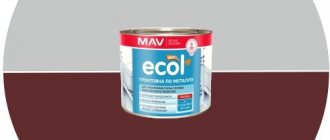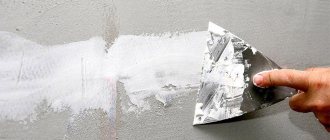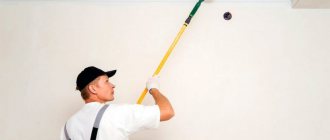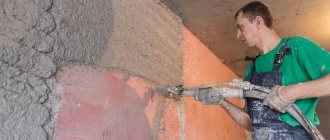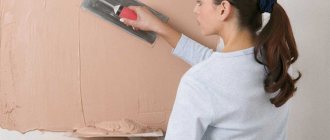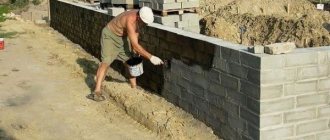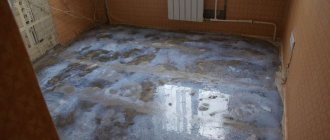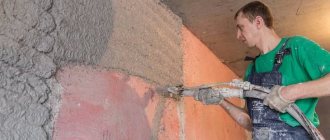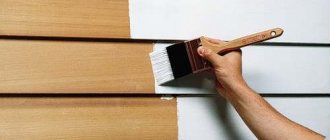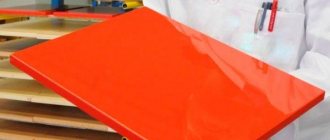The parameter “ Concrete contact consumption ” significantly depends on the porosity of the surface on which it is applied.
Basically, Betonokontakt is used for priming concrete surfaces (hence its name), but can also be applied to other surfaces: brick, drywall, concrete and ceramic tiles, old paint, etc. But even for one type of surface (for example, concrete) the consumption concrete contact can vary significantly.
Price of concrete contact, properties and characteristics, application instructions: Concrete contact
Purpose of the primer composition
When combining two materials with different characteristics, problems arise in most cases. The use of primers can correct the situation even with the most problematic surfaces. Such compositions also include concrete contact. After its application, thanks to the special composition, the surface becomes rough, which significantly increases adhesion.
Manufacturers of concrete contacts use environmentally friendly materials. The mixtures do not have a pronounced odor and do not change the appearance of the walls.
The composition is applied after thorough stirring. The finished primer is used for the following purposes:
- Avoiding damage to the paint structure after painting the walls.
- Increased adhesion during plastering.
- Ensuring reliable adhesion of tiles during gluing to a concrete surface.
- Elimination of defects (small cracks, seams, etc.).
- Preventing destruction and shedding of finishing materials.
For example, primer from the manufacturer Knauf contains acrylic, which provides moisture resistance and high adhesion.
Main characteristics and properties
Concrete contact is a building mixture based on acrylic, which also includes cement, sand and special additives. This mixture is actively used to increase the adhesion of surfaces that do not absorb moisture well, before plastering, laying tiles and carrying out other finishing work.
Among its main advantages are the following:
- high drying speed. Further finishing work can begin a few hours after applying the primer;
- resistance to moisture. During the drying process, a special film is formed that does not allow water to pass through;
- durability. According to the manufacturing company, the concrete contact primer does not lose its qualities for 80 years.
Thanks to its unsurpassed properties, concrete contact has established itself as a unique material that is durable, does not require a lot of drying time and does not allow moisture to pass through. It is these properties that allow you not to worry about the quality of the repairs done.
Consumption depending on surface
Concrete contact primer significantly simplifies working with different materials and allows you to reduce the consumption of finishing materials. Most often it is used for concrete surfaces, but good results have also been seen when applied to brick and drywall.
The consumption of concrete contact per m2 is calculated depending on the type of surface to which it is applied. Its porosity is of decisive importance - this will determine how quickly the composition will be absorbed. The higher the degree of absorption, the greater the consumption.
Surfaces have different absorbencies:
- Low porosity - metal ceramics, painted walls, rubbed concrete. In the examples given, soil consumption per m2 is minimal - 0.15−0.25 kg. The composition is applied in an even layer; no additional leveling is required.
- Average porosity. This is concrete of the highest grade, monoliths, cement screeds, bricks for cladding, concrete tiles. The consumption rate of concrete contact per 1 m2 is 0.2−0.35 kg.
- High porosity. This includes wall bricks, sand concrete and similar materials. For them, per m2 you will need 0.3−0.5 kg. To save primer, experts recommend pre-treating the surface with impregnations that slightly reduce porosity.
The user cannot always determine the degree of surface porosity. To establish the consumption of concrete contact in such cases, a test treatment is carried out. In the experimental area, the boundaries of 1 m² are determined using tape. Take a fixed amount of soil, for example, 1 kg. Begin to apply a layer to the selected area until a uniform coating is obtained. The remainder is weighed, then the consumption of concrete contact per 1 m² of wall is calculated.
What not to do
If you wish, you can find reviews or videos that say that the plaster/tiles have fallen off from Betonkontakt. To prevent this from happening, apply primer only to recommended substrates. In addition, you should not do the following things:
- Dilute the plaster or putty composition with more water than indicated on the package. Yes, it’s easier to work with, but as a result, the putty may collapse.
- Do not apply the composition to frozen ground.
- Do not apply Betonokontakt to an unprepared surface (remove all detachable parts, degrease, remove dust).
- Do not apply BC on a damp base. Dry only.
Eskaro produces a primer for non-absorbent rigid substrates with increased water resistance - When working, do not forget to periodically mix the contents, as sand particles (granules from some manufacturers) fall down.
- You cannot continue work until the primer layer has completely dried (indicated in the instructions).
- Do not work at temperatures below +5°C. This does not mean that it cannot be used for outdoor work. It is possible, but it must be applied at positive temperatures.
- Do not allow dust to enter. It sticks very well to the adhesive surface, but then falls off along with the plaster. If the surface is dusty, another treatment is necessary.
- Do not use a composition that has expired or has been frozen. The exception is frost-resistant compounds (there are such). Before use, they must be defrosted, wait until the temperature rises above +5°C, then you can work. By the way, the inscription “frost-resistant” does not mean that it can be applied at sub-zero temperatures. It can only withstand several defrost/freeze cycles before application without loss of properties.
The German company Bergauf also has an acrylic primer Beton Kontakt - Do not add water, even if it seems that the composition is too thick. Unless the manufacturer described this possibility in the instructions. But so far we haven’t seen any of them.
Famous brands
The primer mixture from different manufacturers has its own characteristics. This also applies to consumption indicators:
- Knauf. The substance is classified as an economical option. The cost of 5 kg of container is 500 rubles. One of the components is quartz sand, which provides surface roughness. Use the mixture for concrete surfaces. Consumption of Knauf concrete contact per 1 m² as a primer is 0.2−0.35 kg.
- Ceresit - ct19. The substance is based on environmental components, which allows it to be used for interior work. Characterized by increased density. The sand included in the composition increases the degree of adhesion. The consumption rate per 1 m2 is 0.2−0.5 kg. The cost of 15 kg is 1 thousand rubles.
- Prospectors. Universal primer mixture. Used for various surfaces, including concrete, gas silicate, and plasterboard. Using this type of soil, you do not need to purchase additional materials. Costs depend on the type of surface. On average, the figures are 0.2−0.3 kg per square meter. m. Price for 20 kg - 1200 rubles.
- Bolars. It is developed on an acrylic basis, which allows the primer mixture to be used for both external and internal work. Thanks to its characteristics, it can be used even on uncleaned surfaces. Of all the options presented, Bolars is the cheapest primer. Concrete contact consumption per 1 m² of wall is 0.3 kg.
Recommendations
- When purchasing, always choose a product that has positive reviews from experts and ordinary customers who have done renovations at home. Cunning and cunning sellers can sell expired material or even a fake; you need to protect yourself from such a mistake.
- If you are unsure whether this particular primer is suitable for the surface, use samplers to check or check with a store consultant. He will tell you which company is best to choose, how to use it, and what surface it is suitable for.
Before you start work, do not forget to rid the required space of excess dust, large and small debris, and dirt. Use a vacuum cleaner for large debris (if it is the floor).
- Be sure to wait until everything is saturated and dry, and only then apply another layer or a final finish in the form of tiles, for example.
- It is better to apply the final finishing option immediately after the primer has dried. If this is neglected, a sufficient amount of dust may accumulate, which will subsequently only lead to a decrease in strength. Therefore, cover your work area with protective material.
- Keep the remaining primer at above-zero temperatures. If the concrete contact freezes, it will lose all its properties and its further use is useless.
- Try to purchase concrete contact from well-known and trusted brands that do not strive to deceive, but value their reputation.
Features of application
The effectiveness of concrete contact depends on a number of conditions . First of all, it depends on the correct execution of several steps:
- Preparing the surface, removing dust and dirt, removing old finishes. If the defects are minor, then plastering is not necessary.
- Treating walls with impregnation or a simple primer mixture before using concrete contact.
- Waiting for complete drying.
- Prime the surface with a thin layer of concrete contact using a roller.
- Allow the mixture to dry within 2 hours.
- Applying the second layer (their number depends on the condition of the surface, and each subsequent layer must dry well).
The surface is ready for puttying or finishing work.
Compared to other primer mixtures, the consumption of concrete contact per 1 m² is about 0.25−0.3 kg. Calculating the required amount is not difficult at all: the consumption rate is multiplied by the quadrature of the surface being treated.
Recommendations for surgery
In order to do the job flawlessly on the first try, it is better to listen (heed?) to the advice that masters share with beginners.
Purchase and preparation of the composition
- Buying a quality product that has many positive reviews is the only way to protect yourself from all kinds of counterfeits. Checking the packaging (expiration date) and quality certificate “without leaving the checkout” will give you a chance to purchase a fresh and efficiently working product.
- If you are not sure which primer is needed for a particular surface, then it is better to get all the information from sales consultants. They will lay out all the necessary information - about the manufacturer, about the concrete contact: consumption, features of the types available for sale.
- After opening the package, the primer, which is similar in consistency to paint, is also thoroughly mixed, for example, with a mixer attachment. An obstacle to applying concrete contact is a high level of humidity (more than 75%). It will not allow the material to dry “correctly”.
The homogeneity of the mixture is the first sign of a quality product. Any lumps in a freshly opened container indicate the opposite.
Surfaces and work
Betonokontakt does not like greasy stains on the paint, so problem areas are washed (wipe) with a sponge, then degreased. The use of a regular primer will allow you to slightly reduce consumption, since it will do its job - it will fill all the cracks in the base. Large and small debris, dirt, unevenness or suspicious areas that threaten to soon crumble are the obstacles that will have to be gotten rid of. A necessary condition for work is a clean but completely dry base. Surfaces that absorb liquid well are a sufficient reason to apply two layers of concrete contact. If the base has serious defects or unusual relief, then re-processing of this problematic surface is also required. The tool is selected based on convenience and surface area. It can be a roller, brush, spray gun
In the latter case, it is important that the size of the nozzle does not interfere with the exit of the mixture components. Wide brushes are ideal
Rollers, on the contrary, increase consumption by absorbing a large amount of the composition. Mandatory drying of each layer, regardless of their number, is a rule that applies to almost all construction work. However, you should not hesitate to fix the finishing material onto the last dried layer. Otherwise, enough dust will settle on it, and it will reduce the contact strength. Protection of the base from it is necessary. If 48 hours have passed after applying the concrete contact, then a new surface treatment will be required: this time with ordinary deep penetration soil.
If not all of the concrete contact is used, then the packaging is stored at room temperature. Sending it to “winter” on an open balcony is prohibited: since after freezing the primer loses its unique properties. The shelf life of the material is from 6 to 12 months.
Online calculator for calculations
Online calculators are available on specialized websites, and their use is completely free. Qualified builders took part in the development, so the likelihood of error is reduced to zero. By going to the desired website and opening the online calculator, you just need to enter the necessary parameters:
- type of primer mixture;
- type of surface material;
- planned number of applied layers.
Many consumers do not believe that priming with concrete contact is necessary, and in order to save money they refuse this procedure. But if quality and the elimination of further problems are a priority, then applying a primer is necessary. The savings are insignificant, and it is sometimes very difficult to eliminate unpleasant consequences.
Is it possible to save money?
No. This is the expert opinion of the manufacturers. They argue that a strong (sometimes even small) dilution of the composition will significantly reduce the adhesive properties of the concrete contact, which means that there is a possibility that it will not be able to stay on the surface. In addition, too liquid a consistency will not ensure the quality of the coating: water will be absorbed or evaporate instantly, and this speed will prevent reliable adhesion.
A possible result of such actions is the formation of cracks. In this case, the entire process will have to be repeated, which means excess material consumption is inevitable. A mixture that is too watery threatens with an invisible drawback that will come back to haunt you in the future: the waterproofing characteristics of the base will be insufficient. The first potential consequence is mold, but there may be others. Since concrete contact does not have any unaffordable, astronomical price, it is simply unreasonable to encounter possible problems due to small benefits.
conclusions
- When purchasing, check the authenticity of Betonokontakt. There is a risk of buying “water”. Ask the seller for documents. The inscriptions on the container must be visible and clear.
- Prepare the surface correctly - this will reduce consumption.
- Do not dilute Betonokontakt with water.
- Apply primer when all dusty work in the room is completed.
- If the soil is completely absorbed, go over again. Don't leave untreated spots.
- Always smile!
Reviews are different. But problems usually arise due to inattention or failure to follow the manufacturer's recommendations. Be careful when purchasing and read the instructions before use - then the consumption will be as expected and the quality will be high.
How and with what is drywall primed for different finishes?
There are several other points that may affect the choice of soil. First you need to decide on the properties of the material. They are as follows: The primer must be applied twice at intervals so that the first layer dries out. Usually wait from 12 to 24 hours. Although many manufacturers claim that 6 hours should be enough.
But it’s better not to rush, because humidity and temperature are different everywhere. The weight of ceramic tiles is quite large, so you need to make sure that they are held firmly. Tile adhesive helps with this, but you can’t do without primer. It’s not difficult to guess how to prime drywall before laying tiles.
It is worth choosing the same deep penetration acrylic primer with antifungal properties. When choosing specific products from different manufacturers, you need to make sure that they are suitable for working with ceramic tiles
It is worth paying attention to the primer consumption for drywall per 1m2. This indicator is always indicated by the manufacturer on the packaging
You should always add about 10% to it to get a real result.
It should also be taken into account that the consumption is indicated for one layer, but you will need to apply the primer in two layers (the second is applied after the first has completely dried). Consumption usually ranges from 100-150 grams per square meter. When the question arises of what primer to use on drywall, you need to decide what types of this material exist.
It is important to choose a material based on the manufacturer, but still, you need to know about its existing varieties. The main types are as follows:
Additional information on the topic:
- How to assemble a frame for a niche in a plasterboard wall photo
- How to hide a beam on the ceiling in a wooden house with plasterboard
- How to install a plasterboard arch on a video profile
- Is it necessary to putty drywall before gluing liquid wallpaper?
- How to glue ceramic tiles to drywall other than tile adhesive
Description of the product
The primer involves treating the top layer of walls (ceiling/floor) in order to increase the adhesion of materials. With the help of a primer, they create an even layer on which paint, glue, etc. lie evenly. At the same time, the consumption of the same paint will decrease, that is, the primer saves building materials and improves the final result.
Thanks to the penetration of the product deep into the pores, a protective, durable layer is created that prevents the formation of corrosion, mold and mildew. By tightly hiding small cracks and defects, Knauf primer mixture promotes a smoother finish. But despite the density of the primer layer, the surface “breathes”.
Properties of Tiefengrund
This mixture does not have a specific odor - a clear advantage for the application procedure. It does not emit harmful substances into the air, which makes it harmless to the human body. Tiefengrund mixture is used for a wide range of surfaces: plaster, brick, concrete, etc.
What is this type of soil?
Manufacturers, of course, keep the exact recipe of the composition secret and everyone has their own. But the general structure is something like this. The mixture has an acrylic base; quartz sand and, in some cases, cement are added to ensure good adhesion. All this is connected, combined and strengthened by various polymer additives and additives.
If we move away from engineering terms, the soil plays the role of butter on a sandwich. That is, it ensures reliable adhesion of the plaster to the base. Its versatility lies in the fact that the base does not necessarily have to be concrete. With the same success, it can be applied to paint, drywall and even old tiles, as long as the base is strong.
A smooth and durable wall is quite difficult to plaster. In order for the composition to adhere to the surface, it is necessary to make it rough; additives and quartz sand are responsible for this in the primer. After using concrete contact, the wall or ceiling becomes like sandpaper and almost any plaster composition will adhere well to it.
Composition characteristics.
If we talk about drywall, then in addition to enhancing the adhesive properties, this type of soil also significantly strengthens the surface of the sheet. In addition, primer is one of the few solutions that can easily cope with stubborn oil or other stains.
The big advantage of the solution is its environmental neutrality. All elements included in the composition are odorless, this allows it to be used for both indoor and outdoor use. Acrylic also provides good vapor permeability to walls. The only limitation is the inability to work in the cold season, when the temperature drops below +5 ºС.
The principle of soil operation.
Betonokontakt: reviews
As you would expect, reviews of concrete contact are in most cases positive. There have still been no disputes about which mixture manufacturer is better. But occasionally there are negative reviews, but they are more likely about sellers, not about manufacturers.
On one of the forums, a man told a terrible story that after applying concrete contact to the ceiling and then whitewashing it, the result was not satisfactory. At first, pinkish reflections could be seen under the layer of white. And after a week, the whitewash began to chip off along with the primer.
Professional builders in this case explain that either the composition was purchased with an expired expiration date or after repeated freezing, or a fake was purchased.
Such cases, unfortunately, do occur. Therefore, if the purchase of concrete contact occurs not in a specialized store, but in the market, then it is better to open the container and check the homogeneity of the mixture. If the solution is not homogeneous, the purchase should be abandoned.
